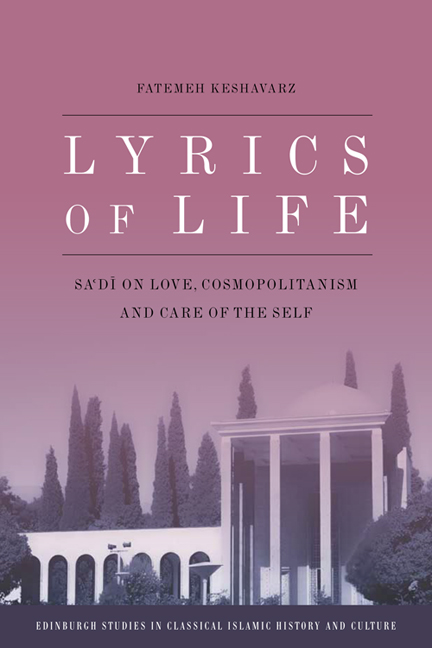Book contents
- Frontmatter
- Contents
- Acknowledgments
- 1 At the Brink of Writing: Which Doors to Open First?
- 2 Cosmopolitan Kinship: The Making of a Multi-world Subjectivity in the Poetry of Sa'di
- 3 Sa'di on Care of the Self: Ethical Games of Power in Practice of Freedom
- 4 “Every New Flower Arriving in the World”: Sa'di and the Art of Ghazal Writing
- 5 Gazing at the Garden of Your Beauty: Love in the Garden
- 6 My Poor Heart Sometimes Runs, Sometimes Whirls: Meet Sa'di the Comedian
- 7 Epilogue: Leaving the Garden Already? Here Are a Few Things I Hope You Take Along
- Bibliography
- Index
7 - Epilogue: Leaving the Garden Already? Here Are a Few Things I Hope You Take Along
Published online by Cambridge University Press: 05 August 2016
- Frontmatter
- Contents
- Acknowledgments
- 1 At the Brink of Writing: Which Doors to Open First?
- 2 Cosmopolitan Kinship: The Making of a Multi-world Subjectivity in the Poetry of Sa'di
- 3 Sa'di on Care of the Self: Ethical Games of Power in Practice of Freedom
- 4 “Every New Flower Arriving in the World”: Sa'di and the Art of Ghazal Writing
- 5 Gazing at the Garden of Your Beauty: Love in the Garden
- 6 My Poor Heart Sometimes Runs, Sometimes Whirls: Meet Sa'di the Comedian
- 7 Epilogue: Leaving the Garden Already? Here Are a Few Things I Hope You Take Along
- Bibliography
- Index
Summary
The problem with exploring something as delightful as Sa'di's lively garden is that you do not wish to leave the place. If you are writing a monograph that must see the light of day in your own lifetime, this could be a problem. The good news is that with a book acting as a portal to the garden, visitors will be invited in perpetually—that is, if they find the visits enticing enough to return. I certainly hope this will be the case with Lyrics of Life: Sa'di on Love, Cosmopolitanism and Care of the Self—and I would like to offer a few keepsakes for you to take along—together with anything else that you may select personally.
First and foremost, the more I wrote on Sa'di's poetry the more I realized that this book was only partially about his work. He had been the bright star that had pulled our gaze to the heavens. But, ultimately, it was the heavens we explored all along. The luxurious low-hanging fruit of his lyrics lured us to the tree of the Persian lyrical tradition. We explored this absolutely familiar edifice and made new discoveries. Indeed, for those of us who are Persian speakers, the tree had been rooted in our life experiences so deeply that we often failed to see it for what it really was. When we had seen it, in our hubris, we had refused to see the tree in its entirety: flowers, thorns, green shoots and dead branches. Other things had remained hidden: the complexity of the non-native shoots that had grafted themselves onto the tree over the centuries and had made it so much more robust. In the same manner, we had often neglected to look at what works in this amazing body of poetry—and ask why it works. Why did so many people, over the centuries, run to the shade of this tree to rest, live a more wholesome life, know more, or see better?
In the Prelude to the book, I examined my personal relationship to Sa'di's poetry.
- Type
- Chapter
- Information
- Lyrics of LifeSa'di on Love, Cosmopolitanism and Care of the Self, pp. 195 - 203Publisher: Edinburgh University PressPrint publication year: 2014

